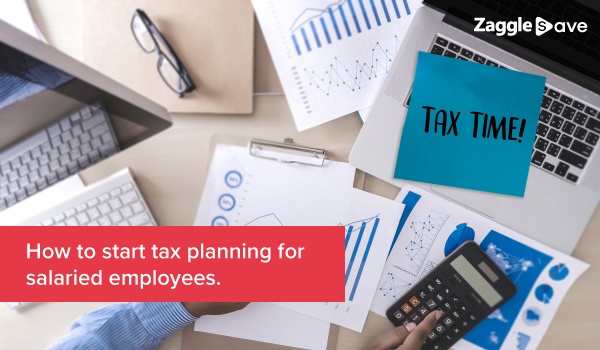For salaried individuals, a significant deduction comes from tax liabilities. Since most professionals only worry about tax when it is time to file IT returns, they end up losing a considerable amount. However, if they practice tax planning best practices, they could avoid last-minute hassle, while increasing their take-home salary.
One major driver of this lethargic behavior is the lack of awareness about the tax regulations. Individuals have a number of opportunities to reduce their taxable income through tax exemptions and deductions. But to leverage these, employees must be clear about their financial commitments. This is why tax planning for salaried employees is essential. It helps them understand areas that can save them taxes. For example, if individuals invest in retirement schemes like PF and NPS, they can reduce their tax liability, while also saving some amount for later years.
In this blog post, we will discuss best practices that must be followed during tax planning for salaried employees.
Tips for effective tax planning for salaried employees
Get a good understanding of tax slabs & applicable percentage
Tax planning for salaried employees begins with understanding the income tax slabs and the associated tax percentage. Once you find out the tax bracket you fall under, you can quickly calculate the tax you owe the government before all the deductions. However, calculating the tax liability is not a straightforward process. You can seek the help of your tax consultant or finance team.
Assess Section 80C thoroughly for relevant tax exemptions
The Income Tax Act allows salaried individuals a total of Rs 1,50,000 of tax exemption and deductions under Section 80C. It is a great opportunity for employees to reduce their taxable income. You can do that by investing in a variety of investment products and schemes, which will increase your savings by securing your retirement. These instruments are discussed below:
- Public Provident Fund (PPF): A mandatory savings scheme with a 15-year lock-in period.
- 5-Year Bank Fixed Deposits (FDs): A 5-year FD program is covered under Section 80C.
- Unit Linked Investment Plan (ULIP): A risk-based investment scheme with returns of up to 5% to 11%.
- Equity Linked Saving Schemes (ELSS): With a 3-year lock-in period, ELSS can give up to 15% of returns in the long run.
- National Pension Scheme (NPS): Retirement savings plan that can give 3% to 10% returns.
- National Savings Certificate (NSC): A government scheme with a 5-year lock-in period.
Get health insurance to qualify for exemption under Section 80D
If you get a health insurance plan, you can claim deductions against the premium that you pay for the plan under Section 80D. You can also leverage this for a health insurance premium that you pay for your spouse, children, and parents. In addition to reducing your taxable income, this section will ensure medical protection for you and your family.
Plan an investment in home for loan benefits
The Income Tax Act has two different provisions that you can use if you have taken a home loan. One tax deduction is offered under Section 80C for the principal amount you pay, while the other one is for the interest applicable on the loan mentioned under Section 24(b). These exemptions can be a part of the tax planning of salaried employees to reduce their taxes, and also achieving the milestone of owning a house.
Tax deduction for education loan
Under Section 80E, you have the opportunity to claim a deduction on an education loan that you have taken for yourself, your spouse or children. This tax exemption is to encourage and facilitate higher studies.
Claim HRA benefits if applicable
HRA or House Rent Allowance can make a significant contribution in the tax planning for salaried employees. Professionals who live in a rented house can claim HRA under Section 10(14). However, the way the exemption is calculated is a little tricky. Let us break it down for you:
The amount that can be deducted under HRA is taken as the least of the below three options:
- (Actual rent paid) – (10% of the basic salary)
- Actual HRA offered by the employer, or
- 50% of the basic salary
Structure your salary to accommodate allowances
Employers can play a key role in tax planning for salaried employees by offering flexible benefits. Individuals who are employed have the option of seeking allowances for a variety of basic necessities like meals, fuel, transport and telecommunication. While these funds are deducted from the salary, they reduce taxable income by a considerable amount.
Zaggle helping HRs in tax planning for salaried employees
Tax planning is an individual activity and is subject to the person’s requirements, needs, and future goals. However, employers can play a critical role in tax planning for salaried employees. Taking cognizance of this new found focus on tax savings, companies are offering flexible benefits as a part of the salary to attract and retain talent. These flexible benefits feature tax-free allowances for fuel, food, transportation, leave travel and so on. Since these benefits need to be tailored for every employee, HR leaders are relying on Zaggle SAVE.
Zaggle SAVE is a digital solution that helps HRs plan, implement and manage flexible benefits programs easily utilizing automation to fastrack operations. Plus, the solution comes with a multi-wallet prepaid card that can be used for relevant transactions.
With SAVE, the allowance money that is deducted from their salary to save taxes is directly sent to their cards. With access to mobile apps, employees can keep a track of their balance funds. Zaggle SAVE has quite a few features that makes tax savings a convenient and flexible task.
To learn more about it, click here.


